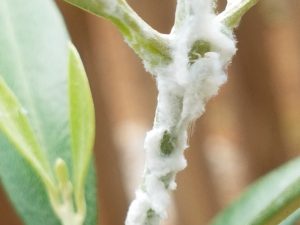Nature is full of examples of animals that use camouflage to protect themselves, and some of the best examples are found in the insect world. They may appear to be leaves, sticks, thorns, or flowers; there are insects that disguise themselves as snakes, bird poop, or other more dangerous insects. While many of these adaptations protect them from predators such as birds or spiders, they may also make it difficult to identify a bug that’s causing a problem in the garden!
There are several insect pests of plants that may not appear to be what they are at first glance. This can make frustrating to figure out what’s harming a plant, and identification is a very important first step in solving any problem. Here are some of the more common critters that wear disguises in our area, though.

The ants in this picture are attracted by the scale insects, which look like oval bumps on the stem of the plant.
Scale Insects vary in shape, but many of them appear to be simply another bump on the stem or leaf of a plant. They often form a waxy covering over their bodies and stay put, simply feeding in place on the juices within the plant. Ants may notice them, however, and are attracted to the sticky, sugary substance that they exude called honeydew. This honeydew drips onto other stems and leaves, and may grow sooty mold, a black or gray coating that might make one think the problem is fungus. Look for scale insects if you notice these signs (and be aware that other insects such as aphids or mealybugs also produce honeydew).

Some psyllids or immature planthoppers cover themselves in white fuzz as protection.
Psyllids, mealybugs, and aphids are all different insects, but some species of each use a waxy coating to protect themselves. This gives them a white, fuzzy appearance that may appear at first glance to be a fungal growth. A close look can reveal the truth – that the fuzz is hiding a plant pest within.
Planthoppers and sharpshooters can be pests of certain plants, including grapes. They may appear to be bumps or thorns on a stem, but usually move or jump if approached.
Caterpillars may disguise themselves in a number of ways. Some may blend in with the foliage that surrounds them, while others appear to be twigs or even the aforementioned bird poop (in the case of the giant swallowtail butterfly, whose larvae enjoy feeding on citrus leaves). It is typically the damage to the plant that is first noticeable. Unlike the other insects mentioned here which feed by piercing into a plant and sucking out the juices, caterpillars have chewing mouthparts. Leaves with holes in them are a good sign that you might have a caterpillar problem.
Remember that not every insect is a pest, and not all pests do enough damage to warrant controlling them. If you need help determining if an insect you’ve seen in your garden or landscape is a problem, contact your local Extension office. You can also find more information on all of these insects and more in our EDIS publications, a few of which are listed below:
Scale insects: https://edis.ifas.ufl.edu/pdffiles/MG/MG00500.pdf
Mealybugs: https://edis.ifas.ufl.edu/in1149
Caterpillars: https://edis.ifas.ufl.edu/topic_landscape_caterpillar_pests
by Evan Anderson, Walton County Horticulture Agent
- The Eastern Lubber Grasshopper - June 5, 2025
- Grass is Growing; Time for Mowing - April 30, 2025
- Variegation, Viruses, and You - June 27, 2024
